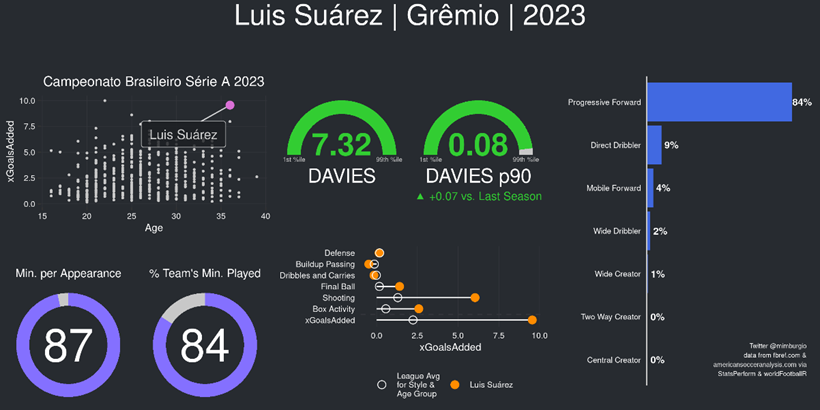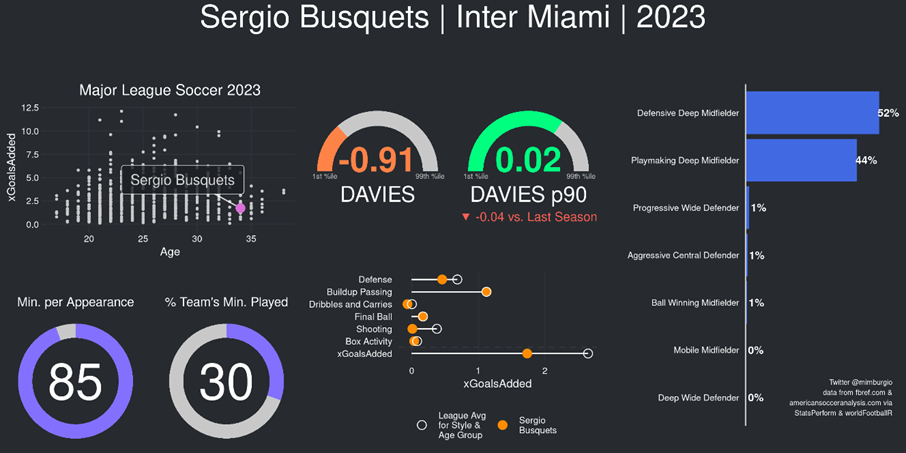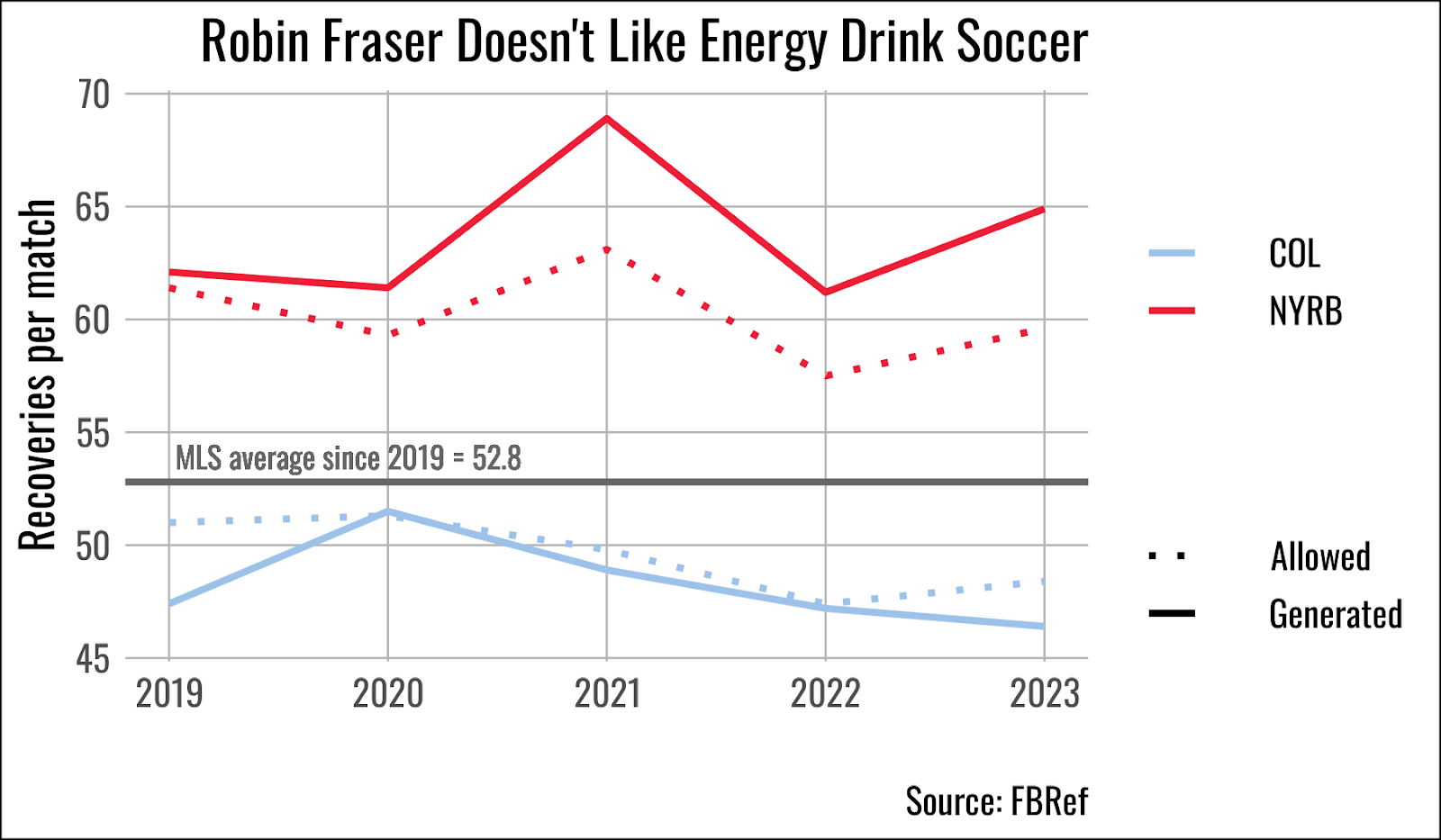Season Previews: Miami, Toronto, Colorado
/Messi Messi Top 10 Moments Messi SEO Messi Schedule Messi Tickets Messi
Miami. City of … something. I don’t know, beaches, presumably. It's’ a town that loves sports, when LeBron is on the team, or the Heat are inexplicably in the finals. But last year, Miami sports fans had something new to excite them, and the city became known worldwide for something else: its proximity to Fort Lauderdale.
What can be said about Inter Miami’s season last year that isn’t obvious. Miami were bad, then Messi came, and they were good, and then Messi got hurt and they were meh. For those skeptical about the claim that Messi is a good soccer player, let me hit you with some facts. When Messi was on the field, Miami had a 1.54 goal differential per match. Notably, however, Miami’s per match expected goal differential when Messi was on the field was just 0.27, which was roughly half that of the Columbus Crew, who lead the league in this category at 0.6 xGD per match. Translation? From my understanding, Messi is a pretty good little player, but it’s hard to imagine that overperformance like this will be sustainable over the course of a full season.
So what did Miami look like on the ball when Messi was on the field? With Messi, Miami averaged 59% possession, which was 2% higher than league leaders, Columbus. What about chance creation? Surely they were elite at creating good opportunities, right? With guys like Messi and Busquets, surely they were creating incredible opportunities at a high volume? Well, yes and no. But, mostly, no.
When Messi was on the field, Miami averaged about 17 non cross passes into the box per game. This would only be good for 12th in the league. They were only averaging 6.3 passes from inside the box, which would be good for 23rd in the league.
What the Messi Miami team were elite at, in terms of passing profile, was through balls. With Messi on the field, Miami averaged 3.2 through balls a game, completing two a game. The non Messi’d teams of the league peaked at just 1.9 attempts and one completed.
When you combine these facts, it’s easy to see why Miami’s average xG per shot was 0.14 when Messi was on the field, with Cincinnati leading the league at 0.12, while their average xA per 90 was only good for seventh in the league at 1.1, with Columbus (is this team bad at anything?) leading at 1.3.
So what do all of these numbers mean? Very little. The sample size on all of these stats are quite low, because Messi didn’t play that many soccer games. Everything you’ve read so far has been a waste of time.
It Really Is Beckham’s Team Huh
It’s hard not to look at Miami’s current situation and compare it to the arrival of David Beckham to the Galaxy. When David Beckham came to the league, he was rushed to play out of obligation and got injured in the process. Sound familiar? The Galaxy notably let Beckham’s team take the reigns and turn to Europe to find aging stars like a 34 year old Abel Xavier, who could no longer run, and picked a coach in Ruud Gullit who had no idea what he was doing. Tata doesn’t fit this comparison, but the European turn is something that will ring true to observers of Miami. The Galaxy further screwed up the team’s ability to gel and find a way to win by taking the Galaxy on a world preseason tour to expand the brand, sell jerseys, and pack stadiums. See what I mean?
None of this went well for the Galaxy, and while Beckham ended up winning two championships, it occured when Beckham fever died down and Bruce Arena was brought in to make this soccer team primarily about soccer. Of course, Messi is a far greater player than Beckham, Busquets, Alba and Suarez are much better than Abel Xavier, and the world tour… yeah, that still sucks. But the general point remains that, while the Galaxy remain a cautionary tale, this Miami team is far better equipped to stave off these mistakes.
The Barca Boys Are Back
With a team that was tearing it up on offense and suspect on defense, the off-season goal for Miami was quite clear: get Luis Suarez. While striker was not an immediate need for Miami, Suarez checks a lot of the boxes that Messi is looking for in a teammate. 1. He played with him at Barcelona. 2. … well, there is no 2. This is not to say that Suarez is bad. Quite the opposite. Despite his age, Suarez is coming off a gangbuster season at Gremio, as you can see by his DAVIES numbers.
While Suarez’s numbers don’t quite have the bite of what they used to be, he still has the potential to have one of the better seasons of any forward in MLS history. Then again, the man is 37 years old, so he may have one of the least impactful seasons in MLS history by tearing a tendon walking his dog on the beach.
Similarly, while not a new addition, Miami will have 35 year old Sergio Busquets anchoring the midfield, despite some serious questions about his legs and the ability to defend.
Another notable addition to the team is MLS veteran, Julian Gressel, who’s the king of the cross in MLS. While a pretty cross is something that many fans enjoy, the actual chance creation value of a cross, no matter who is sending it in, is pretty low, so this isn’t actually where his value lies. Gressel is a versatile player that can play in the midfield or fullback, who’s soccer IQ and general passing ability will fit this team nicely, considering the passing and soccer IQ of the Barca boys he now calls teammates.
So far, it is unclear where Tata is going to play Gressel, with Julian playing attacking fullback in some games, and midfielder in others. In midfield, Gressel would be able to provide some much needed track back ability, however, a defensive mid he is not.
Tata’s approach this pre-season has been to shift Miami from a 4-3-3 to a 5-3-2, with Messi and Suarez playing up top, presumably to help save Messi’s legs, and putting numbers behind the old guys to make up for their oldness on defense. So far, this has led to mixed results, and, by mixed, I mean a mix of losses, with Messi’s minutes being limited and fans chanting for refunds.
The midfield will be the biggest question for Miami going forward. Well, second biggest. With the injury to Facundo Farias, their 21 year old Argentinian rising star, Miami’s main attacking threats are collectively 300 years old (estimated figure). I’ve presented a bunch of charts, but this season really comes down to one thing: Keeping Messi healthy. With a grueling schedule of MLS, Leagues Cup, CCL, US Open Cup, and, if he makes it that far, playoffs, this will be a real challenge for Miami, managing his minutes and praying the injury gods are kind, because, without him, even with Suarez, this team is going to struggle.
But if that happens, fear not, Miami faithful. Bruce Arena is still available.
Let it Bernardeschi
The last two years of following Toronto FC has been nothing but pain and suffering. A 2022 season with the 2nd worst xGD in the entire league saw some green shoots in the emergence of some promising young players. 2023 began with almost all of those green shoots mercilessly sheared for 30+ year old free agent concrete. That went predictably well, as TFC regressed to the worst xGD in the entire league and the Bradley boys had to find new jobs somewhere in the arctic circle. In comes ex-Canada manager John Herdman, who leaves a fairly robust legacy of perhaps the best Canadian men's national team of all time, but off the back of a disappointing World Cup rife with squad troubles. Luckily, he enters a robust and well mannered locker room environment in Toronto.
Vape It Or Leave It
The Reds had the second highest wage bill in the entirety of MLS last year, and as evidenced by the salary plots from our friend Steve Fenn, Lorenzo Insigne and Federico Bernardeschi make more by themselves than all but 3 MLS franchises. I am not going to begrudge Bill Manning and MLSE for choosing to build a squad this way, after all, Giovinco, Bradley, and Altidore dominated the league into 3 finals in 4 years with one of the most dominant shield-title wins ever. However, if those two players stink it really hurts.
Insigne and Bernardeschi sputtered in 2023, with Insigne only playing 1700 minutes. A combined nine goals and six assists just ain't enough. We don’t need fancy models or new aged stats to tell us that. 23 million american dollars for a Daniel Salloi worth of output. Not great! The fancy models liked them just as little. Insigne put up 0.94 g+ above average in his 1694 minutes, while Bernardeschi was -0.63 g+ above average in his 2834 minutes. Over the course the season, your $8M winger is below the league average. I could rag on this for thousands more words, but this is priority #1 for John Herdman and the club. You have to find a way to make them produce, or you have to find them a new home.
The Striker Royal Rumble
As per Toronto’s roster page, the club is currently carrying no fewer than seven players whose primary position could be considered as striker: Ayo Akinola (U22, making $800k), Adama Diomande ($585k), Jordan Perruzza (HG, $130k), Hugo Mbongue (HG, $78k), Deandre Kerr ($90k), Cassius Mailula (U22, $291k), and Prince Owusu ($708k). I have been generous and called first overall pick Tyrese Spicer a winger, but he could see some time up front as well. For those following along at home, that’s $2.7 million dollars (~$1.9M in cap implications) for a gaggle of strikers who scored a combined five goals (all by Deandre Kerr) last season. Turning one of those players into an at least semi reliable striker option is of critical importance to the Reds in 2024.
John Herdman was quoted as saying “This first game against Nashville we'll prioritize physical outcomes and assessment of key positions. People will get opportunities to show themselves.” in the opening days of preseason leading up to the Nashville game. The Reds walked away from that one 2-1 winners across a 120-minute-four-quarters set up, with the starters winning 2-0 on the back of goals from Insigne and Bernardeschi. Starting striker? Deandre Kerr with an assist to Insigne. One to keep an eye on.
Digging Between the Couch Cushions
On the bright side, Toronto FC found some money in 2023. Alonso Coello looks like a totally competent MLS rotation defensive midfielder after graduating from a good TFC II Next Pro team coached by Gianni Cimini. Lazar Stefanovic, a just-turned 17 year old center back from the academy looks like he has a bright future. Draft pick goalkeeper Luka Gavran was a league average (12 GA from 12.7 PSxGA) shot stopper in his late season string of appearances. Kobe Franklin went from nearly released to starting most games at fullback and looking perfectly cromulent. Deandre Kerr pitched in five goals and an assist in 1200 minutes as a rotation striker/winger/attacking midfielder option in a team that never looked even remotely competent. That’s real found money!
Critically, John Herdman and his staff need more of the same in 2024. With new GM Jason Hernandez speaking about the salary cap, "There has to be movement, some level of movement before we can seriously bring players in. There's some cap realities where we're really trying to hit the bullseye.” the club just doesn’t have the wiggle room to add talent in the way they need, so you have to find talent. Develop it.
Two to keep an eye on, midfielder Markus Cimermancic and center back Adam Pearlman. Cimermancic put up a nice +0.05 g+ p96 in MLS Next Pro last season (Alonso, for comparison, was XX the year before) and made the bench for the first team three times. Most of that value came from interrupting, potentially a useful skill for what was a very soft Toronto midfield in 2023. Pearlman had some trials in France before sticking around with the baby Reds, but was a solid +0.05 g+ p96 in Next Pro, again mostly from interrupting. Center back interrupting is a lot less useful than midfielder interrupting, but one to keep an eye on in 2024.
2024…
Not a lot of positivity in this one, sorry folks. I think Toronto FC will be bad again this year (and if I’m wrong, they allegedly beat Columbus and we all know preseason results drive everything)
This Ain’t A League, It’s A Goddamn Armas Race
By Ben Bellman
2024 is the start of the Third Era of Padraig Smith’s Rapids. Robin Fraser’s 2019-2023 tenure was the Second Era, and it was mostly a success, culminating with 2021’s #1 seed finish in the West. But it became clear early in 2023 that Robin, despite being the correct hire in mid-2019, was simply not interested in coaching his team to lean into their strengths and focus on the transition game. His past team often thrived in transition moments, with Danny Wilson and company pinging balls into the open spaces Michael Barrios and Dom Badji were already running into for iconic goals. But during the Fraser era, the Rapids consistently played some of the slowest, offensively methodical, and defensively withdrawn soccer in MLS.
New head coach Chris Armas and the FO want this team to play with intensity and at least some coordinated counterpressing. Using ball recoveries as a proxy for the pace of play, we can see the extreme contrast of styles between how the Rapids and Red Bulls have played on both offense and defense since Fraser took over August 2019 (Armas left as Red Bulls head coach in September 2020). My hunch has always been that this is the right game model for a Moneyball team with a home stadium at altitude. I’m looking forward to seeing my hunch tested.
2024 Depth Chart
The current Rapids FO first found success in a series of intra-league trades from 2019-2020 to rebuild the spine of the roster, earning the pundit nickname Distressed Assets FC. Those MLS players helped get the best from international transfers that had arrived for the 2018 season. This offseason offered a twist on that theme, with Fran and Padraig bringing in proven American players who’s European transfers didn’t go to plan to reinforce some key 2023 transfers. They were also very active in the draft, but I don’t see many pathways to immediate minutes in 2024 for those players.
And shout out to Matt Pollard and Burgundy Wave for being all over this window. When I use the word “reportedly,” it’s their reporting. I give them money and if you’re reading this preview, you probably should too!
Goalkeeper
At first, I was confused about why Colorado signed Zack Steffen. They reportedly paid $800k to permanently sign Marko Ilić from a Belgian club in June 2023, who occupies an international spot, just to sign Zack Steffen to what sounds like a big salary only six months later. BW’s coverage has described this as an opportunistic move (the transfer was free), but why another big outlay for a historically budget-friendly position in MLS?
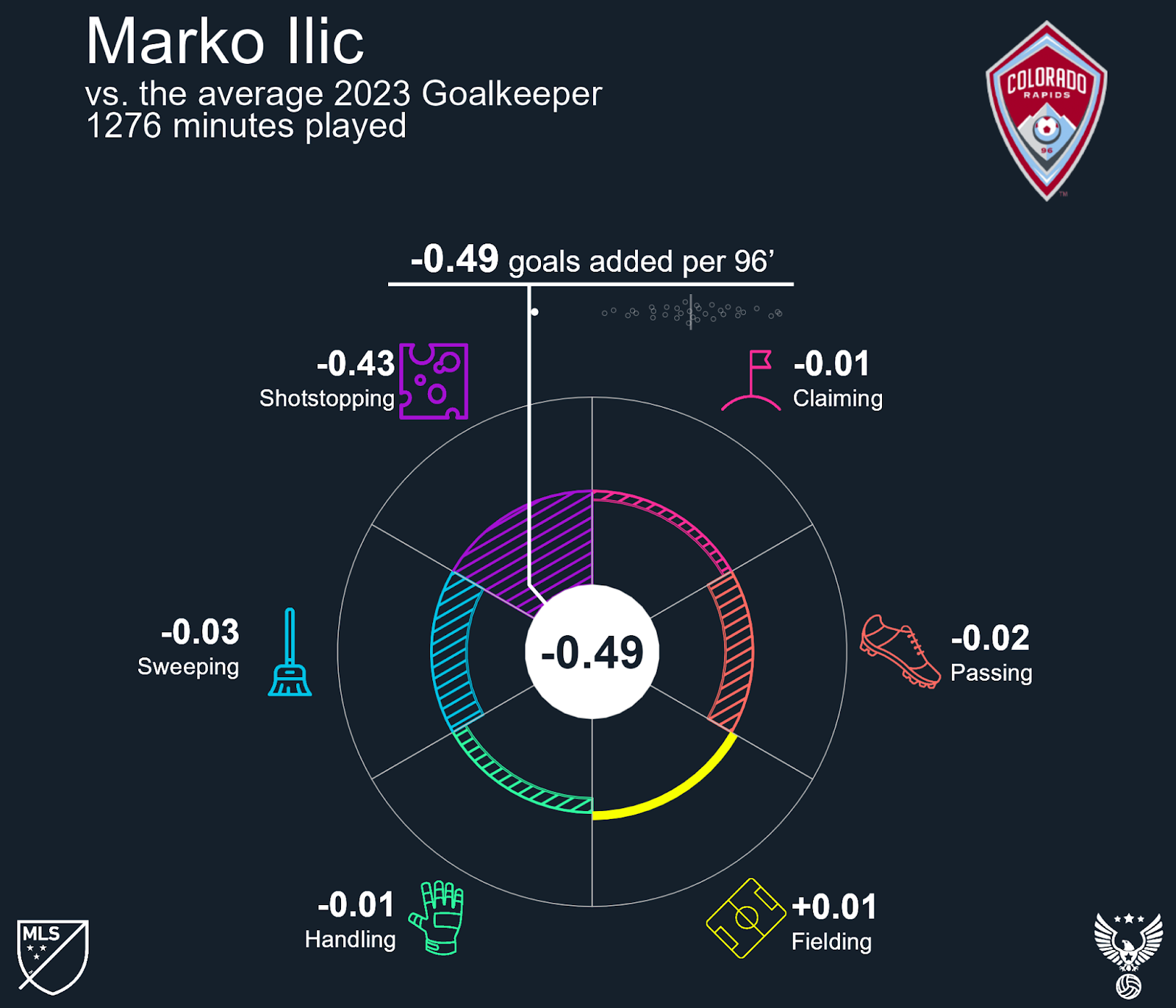
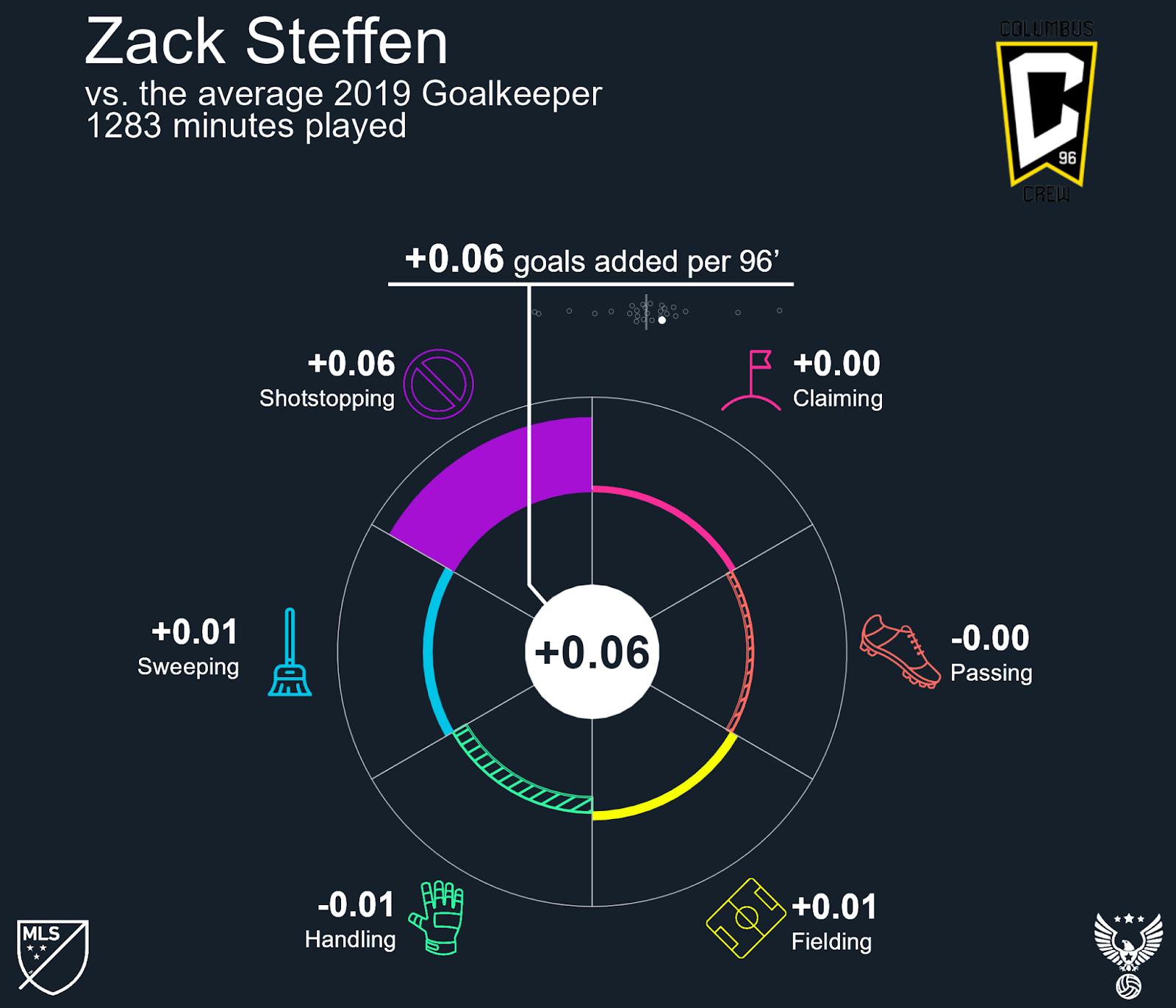
Then I looked at Ilić’s numbers from the backend of 2023. With about a third of the season to work with, he managed to be the very worst keeper to get significant minutes all year, with especially rotten shotstopping. So I now think that getting a reliable domestic keeper for the next few years makes sense. Note the g+ wheel, we thought it’d be funny if the shot stopping logo turned to swiss cheese once you fill the negative side. Ilic fills it seven times. Steffen’s g+ was mostly average through his time at MLS, with a good run of form to start 2019 before going to Manchester City. That’s good for saving an extra goal every other game compared to Ilić’s brief time in MLS.
Depth Players: Adam Beaudry
Defenders
Andrew Gutman was sent to Chicago for fellow left back Miguel Navarro who then was loaned to Argentina to make room for homegrown left back Sam Vines’s return from Royal Antwerp. Vines was great after arriving in Belgium and started most games on the way to winning a league title, but never got a fair shake with the Nats at the time. He then got hurt right before the Qatar World Cup, and returned to the pitch to help Antwerp qualify for UEFA Champions League only to be left unregistered for that competition due to “an administrative error.” I’d been hoping he was looking for a new club after that experience, and apparently a hometown return made the most sense for him. Strangely, g+ and g- do not rate his 2019-21 play in MLS highly. Yet his side of the field stays quiet, and he gets forward to deliver both crosses and shots with pace, so I’ll be watching his play closely to track with the stats.
Center backs Andreas Maxsø (signed for 2023 as a DP), Moïse Bombito, and Lalas Abubakar all return for 2024, as does right back and new captain Keegan Rosenberry. Bombito’s limited minutes in his 2023 rookie year were beyond impressive, and I never understood why Robin sat him so often. He was the team’s shining star in 2023 in both ASA’s goals added and Mike Imburgio’s DAVIES metric. Bombito lives up to his name, bombing into the attack from his deep CB spot with speed, size, and graceful technique on the ball. He just makes the game fun. You read it here first: the young Canadian international will be the most sought after MLS CB in the international transfer market by next winter.
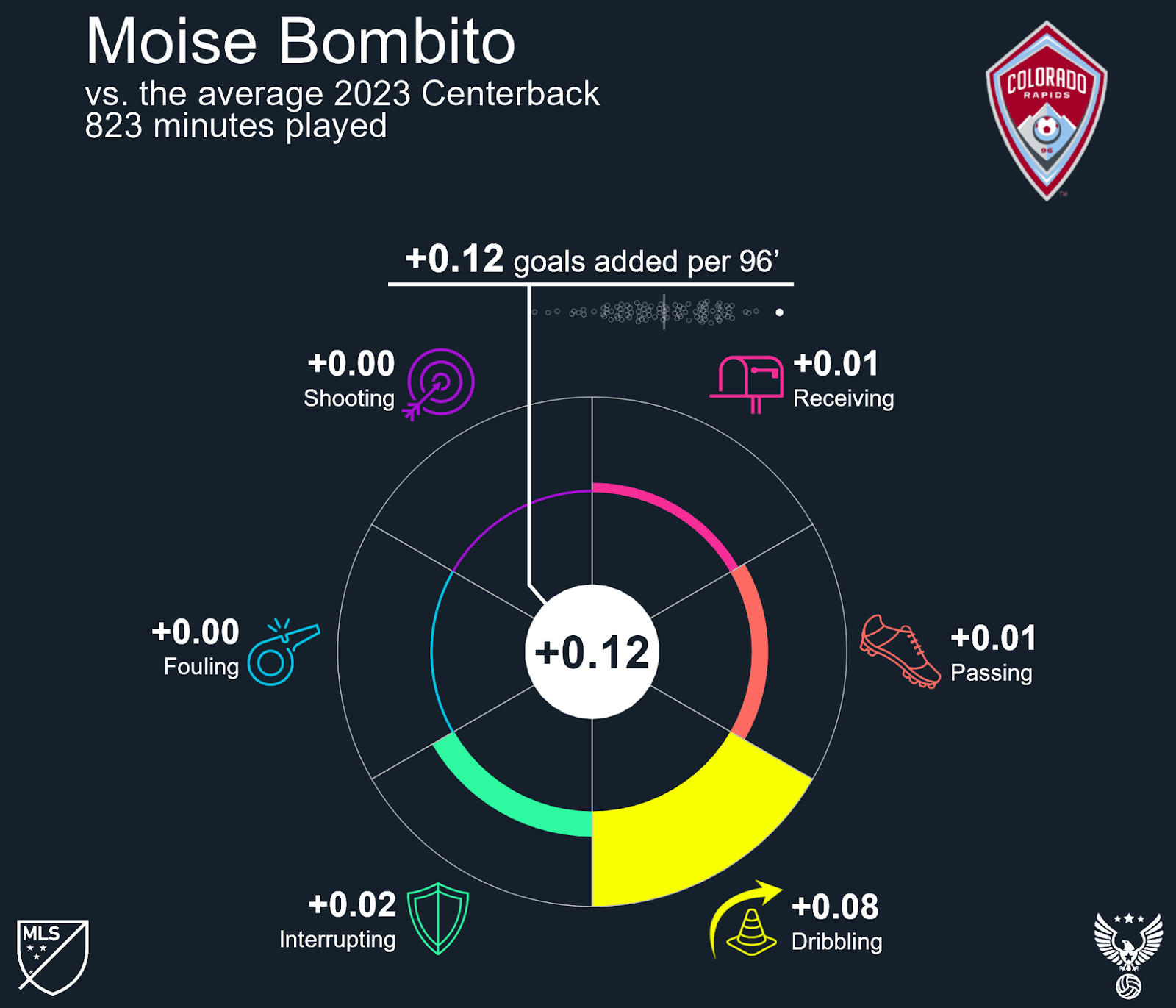

Depth players: Michael Edwards, Sebastian Anderson, Alex Gersbach, Nate Jones, Jackson Travis
Midfielders
Colorado has two key returning players in the midfield: Cole Bassett and Connor Ronan. Bassett took a couple months to hit his stride after returning from a difficult loan stint in the Netherlands, but ended 2023 as the Rapids top goal scorer and produced average-to-decent metrics with his effective runs. Wolverhampton Wolves delivered the Rapids another quality deep-lying distributor and set piece specialist with Ronan, so expect the team to continue to use him as a fulcrum for getting into dangerous areas.
The Rapids signed three new midfielders that will start games and must make an impact. Djordie Mihailovic returns to MLS after a short stint at AZ Alkmaar for a club record transfer fee, and he seems to be planning for a long stint as a Rapids star. Omir Fernandez was the youngest MLS free agent in its short history this offseason. He’s a Red Bulls homegrown and fits Armas’s vision of energetic attacking perfectly. Finally, Lamine Diack is a Senegalese midfielder arriving on loan from Nantes, who were obligated to buy him from a Turkish club after an initial loan in the summer. He never cracked the Nantes first team, but his stat profile reads like defensive enforcer, which is a perfect pairing in deep midfield with Ronan’s top passing skills and slight stature. If that combination is even remotely successful, expect Diack to stick around this summer. Sidnei Tavares was brought in last year with the U22 initiative and he might play some, but I didn’t see anything from him in 2023 that made me think he should stay after his loan from Porto ends in the summer.




Depth players: Oliver Larraz, Jasper Löffelsend, Yosuke Hanya, Ralph Priso-Mbongue, Wayne Frederick
Forwards
For a team that scored the fewest goals in 2023 (26, tied with Toronto), you might be surprised the Rapids did not add any new forwards. I’m not surprised or concerned. Rafael Navarro joined in 2023 as a DP on loan right before the long Leagues Cup break, then his coach got fired, and he helped the team build some form under an interim manager. He often moved deeper to help in build up play. His loan lasts until the summer window, when the FO have a $4.5m option to buy his contract. His 2023 numbers were bad, but it’s a small sample with a lot of adversity, and he deserves the chance to start through June and earn a spot in the new coach’s system. I doubt the Rapids buy his contract at that price, but negotiating the fee down is still an option. If it doesn’t work out for Navarro, I’ll bet Fran has other striker options brewing for a summer move.
The wing positions will likely see a lot of rotation given the pace of play expected from them. Mihailovic and Fernandez can both line up on either wing or underneath a striker. Kévin Cabral (the final DP) continues to show flashes of potential in MLS without any final product.
Depth Players: Darren Yapi, Calvin Harris, Jonathan Lewis, Kimani Stewart-Banes
Potential Starting Lineup
Everyone says Armas likes a 4-2-3-1, and the roster seems well suited to that formation. I expect that the front four attackers will run a lot and rotate a lot game-to-game, so this lineup is who I suspect are the Rapids’ best players in their best positions. Defenders will choose their moments to get forward and press a numerical advantage in transition. Ronan will spray dimes for a dynamic set of runners, and hopefully Diack can stop the bleeding down the gut so that Maxsø isn’t scrambling every other possession.
Outlook for 2024
The vibes couldn’t be better given how bad last year was. The roster was getting younger slowly, then it happened all at once. The new players are talented and want to prove themselves. The new coach will play the style I wanted to see from his predecessor in both the good and bad times. It’s the start of a new project, but this dish has been cooking since at least last spring.
The roster will need more work in the summer: my projected best XI lineup has two players with loans expiring halfway through the season. But we’ve seen most recently from Cincinnati and Houston how fast an MLS team can turn losses into wins. The Rapids look like a coherent team that can compete for playoff seeds #5 through #9 in the chaos factory that is the 2024 Western Conference.



